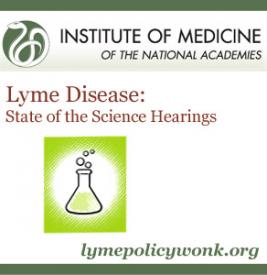LYMEPOLICYWONK: Ann Lyons’ Comments to IOM Committee

I am posting the written speeches of those who commented during the public comment period of the IOM. The speech below is that of Ann Lyons, Vice-President of Time for Lyme, who addressed the testing issues in Lyme disease as well as the disease definition issues related to Lyme disease. Her testimony is available as a downloadable pdf by clicking the link at the bottom of this blog post.
My name is Ann Warren Lyons. I am an attorney, admitted to practice in the Commonwealth of Massachusetts and the First Circuit Federal District Court. I am Vice President of Time for Lyme and have had multiple years of experience with Lyme disease, personally as well as with the thousands of people I support through my work. I am here to speak on behalf of those who are unable, my family and countless families I work with each year both nationally and internationally.
The IDSA reconvened a panel as a result of a settlement agreement with the CT Attorney General Richard Blumenthal. Their decision was released on April 22, 2010, and they upheld their 2006 Guidelines. They believe that the status quo is adequate. What they failed to address is one of the Guideline directives regarding the effectiveness of testing. They did not vote on this pertinent issue, which supports their position that the testing is required for a positive diagnosis of Lyme disease.
This is a failure on the part of this panel to address one of the most critical issues of the dilemma, which Lyme disease presents to both patients and doctors.
The only currently available useful laboratory tests are the Immunologically based ELISA and Western blot assays. The recommendation was made in 1994 to have a two-tiered testing system in which the Western Blot would only be done on ELISA-positive samples. The recommendation was based primarily on the results obtained from patients with arthritis, did not take into account the chronic form of the disease, and was made despite the lack of consistent reproducibility of results between various laboratories.
The ELISA has been shown to be an unreliable test in many patients with Lyme disease, both in early infection and later disease. Part of the reason for the lack of sensitivity of the ELISA is the use of whole organisms, resulting in a high amount of background absorbance. After correction for the high background, only a small percentage of positives can be detected. Because Western blots separate the proteins of the borrelia, specific reactions can be visualized, and more accurate interpretations of the results can be determined.
Even armed with this knowledge that a Western Blot may be more sensitive, countless people are not being diagnosed. For example, with the 6 members of our family, only one had a positive ELISA and he is the least symptomatic. Perhaps his immune system was more competent which is why he not only responded with a positive antibody but also was able to launch an antibody response. What role do the co-infections play, in his case he had none. This disease has presented differently for every member of my family.
There has been an attempt to separate “late” Lyme disease from “chronic” Lyme disease, the former being manifested by objective signs of arthritis or neurological disease. Some have denied the existence of chronic disease, inferring that these patients suffer from psychiatric disorders. Some have used the term “chronic” to mean post-treatment disease (“post-Lyme”), assuming that the infection has been treated, and the remaining symptoms are in the same realm as those patients who have “fibromyalgia” or “chronic fatigue.”
These assertions are speculative and remain unproven. That chronic Lyme disease actually exists, and is likely the most common form of the disease, is supported by epidemiologic studies some demonstrating that over 30% of treated and untreated patients go on to develop a multisymptom disorder typical of, and seemingly indistinguishable from fibromyalgia and chronic fatigue. Unlike these other syndromes, Lyme disease has a known etiology. Chronic Lyme disease consists of fatigue, arthralgias and myalgias, and other nervous system dysfunction. Furthermore, the results of treatment studies appear to support the hypothesis that persistent infection is responsible for the chronic symptoms.
It is likely that Lyme disease will serve as a useful model for other chronic multisymptom disorders. Whether the pathogenesis of “late” Lyme disease differs from that of the chronic form of the disease remains to be established. You cannot underestimate the effect of Lyme and other tick-borne illnesses on society. For the individual, there is physical and emotional suffering. For the family, there is the burden of financial hardship. For communities, there is the financial burden of educating children in schools with cognitive, physical and visual deficits. For the states, the expanded numbers of people needing assistance from Medicaid… and for the federal government, the cost associated with the increased number of people needing Social Security Disability and increase in Medicare costs.
We do not know understand the enormity of this disease, as the surveillance numbers are based on unreliable tests. We also do know the impact of the co-infections and those co-infections that remain unknown.
Today, we are relying on you to look at this holistically.
Thank you.
You can follow additional comments on Lyme policy at www.lymepolicywonk.org. You can contact Lorraine Johnson, JD, MBA at lbjohnson@lymedisease.org.




















We invite you to comment on our Facebook page.
Visit LymeDisease.org Facebook Page